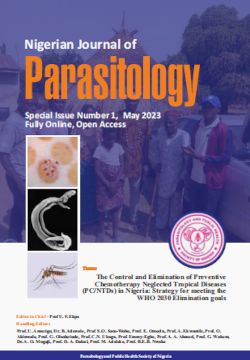Malaria among the Trans Human Pastoralists along the Gurin-Cameroun International Border, Fufore Local Government Area, Adamawa State, Nigeria
DOI:
https://doi.org/10.4314/njpar.v45i1.11Keywords:
malaria intensity, malaria prevalence, nomadic, settlements, Trans-human pastoralistsAbstract
Malaria parasite infection is one of the global commonly ignored infections. Nigeria has both the highest case and mortality rate of malaria infection. This study examined the prevalence and intensity of malaria among transhuman pastoralists along the Gurin-Cameroun international border, Fufore Local Government Area, Adamawa State after major ITN distribution in the study area. Five nomadic settlements: Jaringel; Wuro-nelbi Waziri, Wuro-nelbi Marafa, Wuro-Kosau and Mbodere were assessed using thin film slides blood samples for the presence of malaria parasites. The total malaria prevalence in the sample areas was 24.23%. The study showed that Wuro-Kosau had the highest malaria prevalence of 35%, and the lowest prevalence was found in Wuro-nelbi Marafa which had a 20% malaria prevalence. Also, the highest malaria prevalence of 57% was recorded in the children within the age distribution of (1-10) years, while the lowest prevalence of 5.4% was observed in the 41-50 age distribution. The study also established a link (x = 4.471, p = 0.023) between malaria prevalence and gender in the study population. The higher malaria prevalence occurred mostly in males (62.4%) compared to females (37.6%). Malaria intensity was also higher among males (52.7%) compared to females (46.3%) (x = 20.78, p = 0.011). This called for a proactive measure to ensure a malaria-free society. There is a need to intensify ITN campaign and the importance of using ITNs. Proper monitoring of the use of ITNs should be put in place.
References
Olowe, O. A., Olowe, R. A., and Awa, O. A. (2014). The burden of malaria with historical perspective in Nigerian concept and world
view. El Mednifico Journal, 2(3): 266- 273. DOI:10.18035/emj.v2i3.183
World Health Organisation (2020). Global Malaria Report,” Geneva, Switzerland: World Health Organisation. https://www.who.int/teams/global-malariaprogramme/reports/world-malaria-report2020. Accessed November 2022
Ajegena, B. K., and Oti, V. B. (2018). The Challenges of Using Insecticides Treated Nets (ITNs) in Curbing Malaria in Nigeria: A 2000-2018 Systematic Review. Journal of Infectious Diseases and Epidemiology, 6(4), 1-8.
National Demography Health Survey (2018) “National Demographic and Health Survey,” Abuja, Nigeria: National Population Commission.
https://www.dhsprogram.com/pubs/pdf/FR359/FR359.pdf. Accessed November 2022
Gidigbi, J., M., A., and Enyoh, C. E. (2020). The Problem in Disguise: A Review Paper on Generous Uses of Polyethylene Bag (Nylon Bag) in Nigeria and its Environmental Implications. 7(6):602-610. AIMSPRESS Environmental Science, 602-610.
Aderibigbe, S. A. (2014). Ownership and utilisation of long lasting insecticide treated nets following free distribution campaign in South West Nigeria. Pan Africa Medical Journal, 1-7.
Abbo, B. M. (2011). Implementing Nigeria’s Nomadic Education Programme (NEP). Kano: Commonwealth Education Partnership. https://www.cedol.org/wp-content/uploads/2012/02/BashirMuhammad-Abbo-article.pdf. Accessed November 2022 World Health Organisation (2019). Nigeria intensifies cross-border immunization, with special focus onnomadic populations. Abuja, Nigeria: World Health Organisation. https://www.who.int/news-room/featurestories/detail/nigeria-intensifies-crossborder-immunization-with-special-focuson-nomadic-populations. Accessed onNovember 2022.
Carballo, M., and Nerukar, A. (2001). Migration, refugees, and health risks. Emerging Infectious Diseases, 7(3 Suppl), 556 – 560. https://doi.org/10.3201/eid0707.017733
National Population Commission (2006) National Population Census, Abuja:National Population Commission,http://www.population.gov.ng
/index.php/publication/140-popn-distri-bysex-state-jgas-and-senatorial-distri-2006 assessed on November 2022.
Khobe, D. (2019). Evaluation of the Ecological Health of Some Adamawa State Rangelands. Germany: Lambert Publishing House.
Anikwe, C. C., Irechukwu, J. C., Okorochukwu, B. C., and Ikeoha, C. C. (2020). Long-Lasting Insecticide-Treated Nets: Assessment of the Awareness and Utilization of Them among Antenatal Clinic Attendees in Abakaliki, Southeast Nigeria. Journal of Tropical Medicine, 12-34.
Atinga, A., Babylon, P., Galaya, T., and Obiano, E. C. (2019). Evaluation of LongLasting Insecticidal Nets Mass Distribution Campaign and Malaria Among Under-Five Children in Mayo Belwa L.G.A., Adamawa State, Nigeria. International Journal of Biomedical Laboratory Science, 8(1), 28-33.
Fokam, E. B., Dzi, T. J., Ngimuh, L., and Enyong, P. (2016). The Effect of Long Lasting Insecticide Bed Net Use on Malaria Prevalence in the Tombel Health District, South West Region-Cameroun. Malaria Research and Treatment, 21-32.
Komomo, E. A., Egena, R., and Akintoye, C. I.(2016). Assessment of the Utilization of Insecticide Treated Nets (ITNs) in Calabar Metropolis, Cross River State, Nigeria. Journal of Health, Medicine and Nursing, 26, 1-10.
Bawa, S., Afolabi, M., and Abdelrahim, K.(2018). Transboundary nomadic population movement: a potential for import-export of poliovirus. BMC Public Health, 18(4), 1316-1322. doi:https://doi.org/10.1186/s12889-018-6190-2
United Nations Children Fund. (2022). Long-lasting Insecticidal Nets - Supply Update. New York: United Nations Children' s Fund.
https://www.unicef.org/supply/media/13951/file/LLIN-Market-and-Supply-UpdateOctober-2022.pdf Accessed on November, 2022
World Health Organisation (2018) WHO Global Malaria Programme brochure,Geneva, Switzerland: World Health Organisation.
https://www.who.int/publications-detailredirect/9789241565653 Accessed on January 2023
Okiring, J., Epstein, A., and Namuganga, J. E. (2022). Gender Difference in the Incidence of Malaria Diagnosed at Public Health Facilities in Uganda. Malaria Journal, 1-15. doi:10.1186/s12936-022-04046-4

Downloads
Published
How to Cite
Issue
Section
License
Copyright (c) 2024 Nigerian Journal of Parasitology

This work is licensed under a Creative Commons Attribution-NonCommercial-NoDerivatives 4.0 International License.




